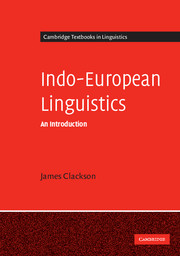Book contents
- Frontmatter
- Contents
- List of figures
- List of tables
- Preface
- Transliteration conventions
- 1 The Indo-European language family
- 2 Phonology
- 3 Morphophonology
- 4 Nominal morphology
- 5 Verbal morphology
- 6 Syntax
- 7 Lexicon and lexical semantics
- Glossary
- References
- Word index
- Language index
- Person index
- Subject index
5 - Verbal morphology
Published online by Cambridge University Press: 05 June 2012
- Frontmatter
- Contents
- List of figures
- List of tables
- Preface
- Transliteration conventions
- 1 The Indo-European language family
- 2 Phonology
- 3 Morphophonology
- 4 Nominal morphology
- 5 Verbal morphology
- 6 Syntax
- 7 Lexicon and lexical semantics
- Glossary
- References
- Word index
- Language index
- Person index
- Subject index
Summary
Introduction
In the documented history of many IE languages, the verbal system has undergone complex restructuring, while the nominal system remains largely unaltered. In Russian, for example, the nominal cases largely continue the forms and functions of the cases of Common Slavic, with the most significant change the loss of the dual number, but the Russian verb is radically different from the Common Slavic verb. The category of aspect has come to dominate the verbal paradigm, with a concomitant loss of tenses such as the imperfect, and the creation of new tenses such the imperfective future. In Modern German the case system of Old High German is more or less maintained, but new periphrastic verbal formations, such as the werden future, have developed over the same time. In other languages, such as the Romance group or English or Swedish, the noun has lost case differences, but the categories of the verb have been maintained and even expanded (note, for example, the ‘conditional’ tense of French, or the -ing present of English). It appears, in Indo-European languages at least, that verbal systems undergo greater changes than nouns. If this is the case, it is not difficult to see why. Verbs typically refer to processes, actions and events, whereas nouns typically refer to entities. Representations of events are likely to have more salience in discourse, and speakers seek new ways of emphasising different viewpoints of events in discourse.
- Type
- Chapter
- Information
- Indo-European LinguisticsAn Introduction, pp. 114 - 156Publisher: Cambridge University PressPrint publication year: 2007

